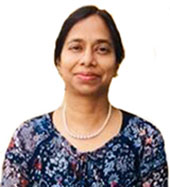Series to Highlight Women in Signal Processing: Dr. Anubha Gupta

 In this issue, we interviewed Dr. Anubha Gupta. Anubha received her PhD. from the Indian Institute of Technology (IIT), Delhi, India in 2006 in Electrical Engineering. She did her second Master's as a full-time student from the University of Maryland, College Park, the USA from 2008-2010 in Education with a concentration: Higher Education Leadership and Policy Studies. She worked as Assistant Director with the Ministry of Information and Broadcasting, Govt. of India (through Indian Engineering Services) from 1993 to 1999 and as faculty for about 10 years before joining IIIT-Delhi in Dec. 2013, where she is currently working as a Professor. She also worked as the Director of Assessment in the office of the Provost at Bowie State University, Maryland, the USA from October 2010 to April 2011. She has authored/co-authored over 100 technical papers in refereed journals and conferences and has published research papers in both engineering and education. Dr. Gupta is a senior member of IEEE Signal Processing Society, a member of IEEE Women in Engineering Society, Chair of IEEE SPS Delhi Chapter, and is currently serving as an Associate Editor of IEEE Access journal. Her research interests include solving real-life problems using AI, particularly, in biomedical areas of cancer imaging, cancer genomics, fMRI, MRI, EEG, and ECG signal processing. More details about her research work are available on her lab page (http://sbilab.iiitd.edu.in/index.html).
In this issue, we interviewed Dr. Anubha Gupta. Anubha received her PhD. from the Indian Institute of Technology (IIT), Delhi, India in 2006 in Electrical Engineering. She did her second Master's as a full-time student from the University of Maryland, College Park, the USA from 2008-2010 in Education with a concentration: Higher Education Leadership and Policy Studies. She worked as Assistant Director with the Ministry of Information and Broadcasting, Govt. of India (through Indian Engineering Services) from 1993 to 1999 and as faculty for about 10 years before joining IIIT-Delhi in Dec. 2013, where she is currently working as a Professor. She also worked as the Director of Assessment in the office of the Provost at Bowie State University, Maryland, the USA from October 2010 to April 2011. She has authored/co-authored over 100 technical papers in refereed journals and conferences and has published research papers in both engineering and education. Dr. Gupta is a senior member of IEEE Signal Processing Society, a member of IEEE Women in Engineering Society, Chair of IEEE SPS Delhi Chapter, and is currently serving as an Associate Editor of IEEE Access journal. Her research interests include solving real-life problems using AI, particularly, in biomedical areas of cancer imaging, cancer genomics, fMRI, MRI, EEG, and ECG signal processing. More details about her research work are available on her lab page (http://sbilab.iiitd.edu.in/index.html).
We approached her with a few questions:
Q. Why did you become a Professor at IIIT-Delhi?
I was born into a family with meager resources. Both my parents are high school graduates. My mother has impacted me most in my life. Although she is a homemaker, she always wanted her daughters to be working professionally and be financially independent. I always liked mathematics and physics because they did not require memorization, unlike biology. While my younger sister chose the medical stream, I moved to engineering. I started my career with the Indian (Engineering) services in 1993 as Assistant Director in All India Radio, Ministry of Information and Broadcasting, Govt. of India. In those days, this was considered one of the most prestigious jobs. I worked there for more than five years, completed my master’s from Delhi University while in a full-time job, but eventually developed the desire to do a Ph.D. I did my Ph.D. at the EE department of IIT Delhi from 1999 to 2006. From 2000 to 2008, I also worked as a faculty at Netaji Subhas Institute of Technology (NSIT, now NSUT), Delhi University. Post Ph.D., I again longed for more learning. This time, I wanted to know the issues in higher education such as access, retention, financing, autonomy, accountability, and so on. I did my second master's as a full-time student from 2008-2010 from the College of Education, University of Maryland, College Park. Post this, I also worked from Oct. 2010 to April 2011 as the director of assessment in the office of the Provost at Bowie State University at Maryland. However, I realized that I am too passionate about the engineering field and perhaps cannot think of dropping out from there. I moved back to India in 2011 and joined academia as faculty.
Currently, I am working as a full professor at IIIT-Delhi, India. Interestingly, I liked all the jobs I did. I felt truly inspired in the first job at ALL India Radio, felt exhilarated teaching engineering students in my second job, felt equally satisfied in my role as the director of assessment helping the university with its assessment processes. But my longing for learning kept pushing me to pursue knowledge in different but related aspects. In the end, I would say, I feel extremely satisfied as a teacher and researcher, helping shape the next generation of engineers as well as contribute to society by doing meaningful research.
Q. How does your work affect society?
My Ph.D. work was related to estimating wavelets from a given signal itself. However, I faced a few challenges because the reviewers always wanted to see the application. I felt inspired to choose the biomedical area because the research can find utility in real life in curing patients. Because I started late in my academic job and then too made a few transitions, say, to master’s in education post-PhD, I landed in a stable research position only after 2011. For the past 6 years, I am working with the cancer department of All India Institute of Medical Sciences (AIIMS), New Delhi. We are working in blood cancers analyzing microscopic images and genomics data. I hope that in the near future, our joint efforts may lead to some low-cost AI-enabled tools for cancer detection that can be easily deployed in urban as well as rural areas. In addition, we are also analyzing EEG data, ECG data, and cancer survival data for different medical disorders/diseases. One of the important contributions from my lab is in the area of estimating wavelets from given signals- compactly supported wavelets, with integer downsampling or rationally decimated filterbanks. In the near future, I would like to see their application in biomedical areas. Recently, one of my Ph.D. students worked on energy harvesting ADCs with some of the best academic partners and colleagues. The core idea is simple. When we sample a signal to convert from continuous-time to discrete-time, why not harvest energy from the signal waveform that is otherwise wasted. This work will also prove important in the near future in designing self-powered devices.
Q. What challenges did you face to get to where you are today?
I would say that I am too fortunate that my parents and my siblings always supported me. In my opinion, as we go in our lives, we face challenges, some people experience more and some less. But in the end, whether we succeed or lose depends on the skillset that we have at that time to thwart those challenges. Whenever I failed, I introspected within me as to what skills I lacked or how I can utilize best the experience of failure and my changed environment and/or circumstances to my advantage in the times to come. I strongly believe that “every failure is a stepping stone to success.” But, to my understanding, we need to make efforts to translate this failure to success. I experienced many stumbling blocks and failures, but I am moving ahead with more learning. Today, I am satisfied with where I am, although I still have a desire to do a lot more than what I am currently doing.
Q. What advice would you give to scientists/engineers in signal processing?
My first advice is to “understand your signals”. To me, this is really important. There are a lot of tools and methods in signal processing. We should not apply any method or tool as a black box or because others are using it. Instead, we should have a good understanding of our data, particularly, from the point of view of the application we are working in. I feel that “data speak” and we need to have ears for that. In other words, once we understand the data and are able to listen as well as see through it, we will know which tool will work best or whether we need to innovate a new method that will help us achieve our target. Many times, I see that students do not even visualize the data. This is not helpful at all. Whether it is time-frequency analysis, CNN architecture, or any other signal analysis, visualizing or playing data at different stages of the method tells us a lot about what is happening and what we want to achieve. My second advice is to understand the methods with their pros and cons. Use a method that is appropriate and not that is fancy to hear.
Q. Anything else that you would like to add?
I believe there is one life and one should possibly do whatever experiments one wants to do, of course, in creative ways. I have hopped from administrative jobs to teaching & research twice. I felt happy all the time and did whatever I wanted to do. We all can contribute in positive ways to society with whatever jobs we do. If we are happy and inspired, we can contribute in a lot many more ways other than being stuck up in jobs that we may not like.

